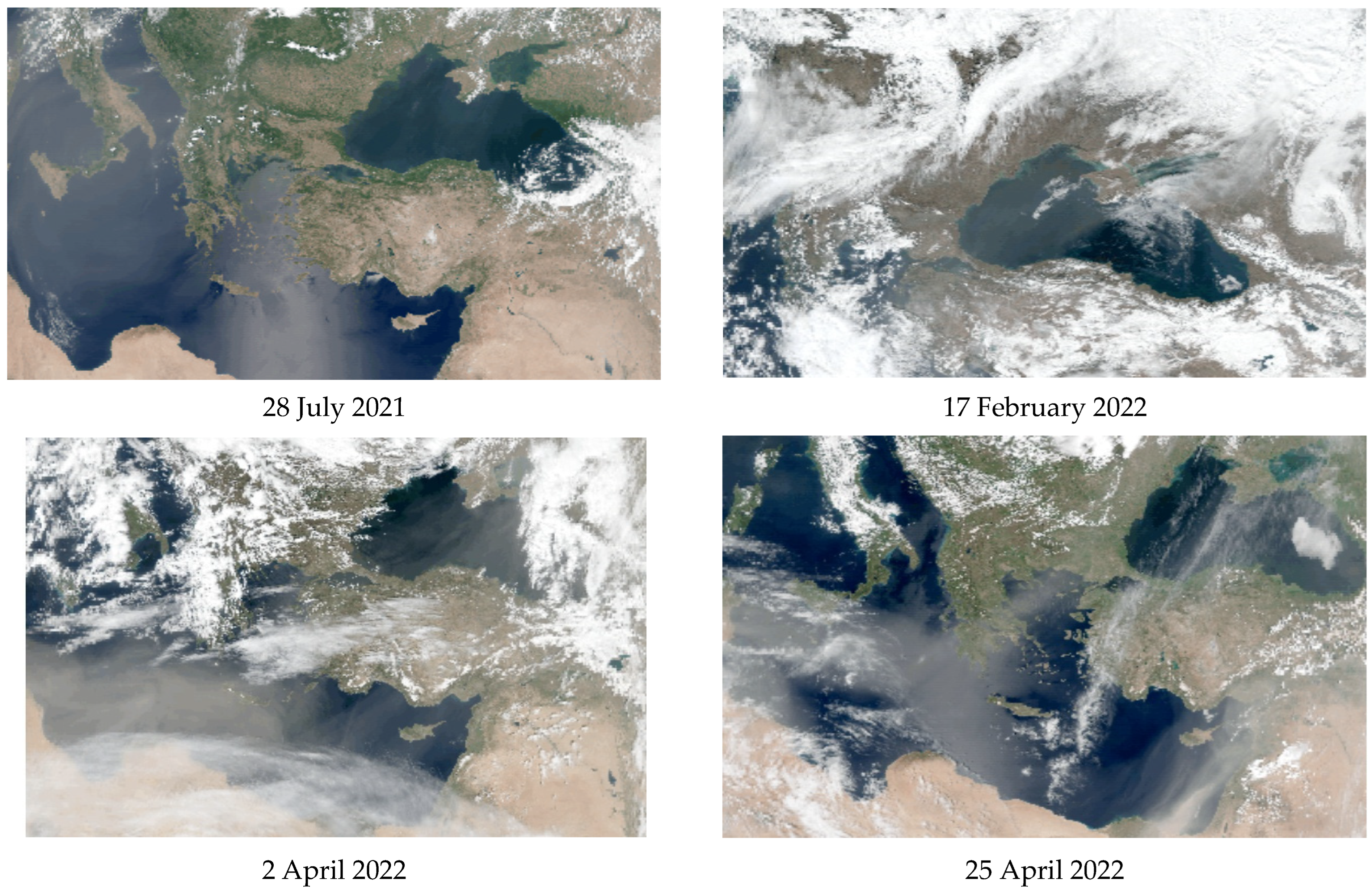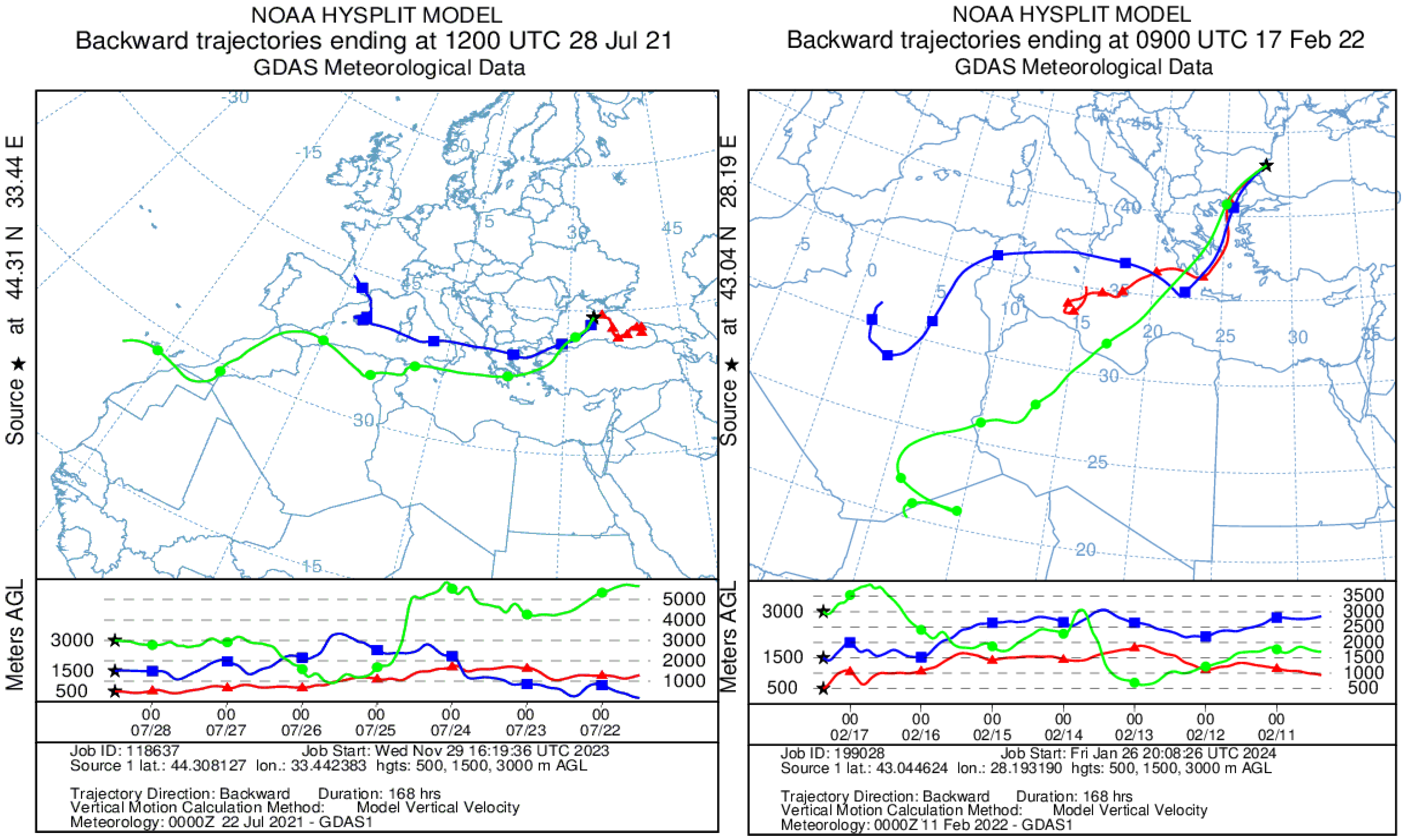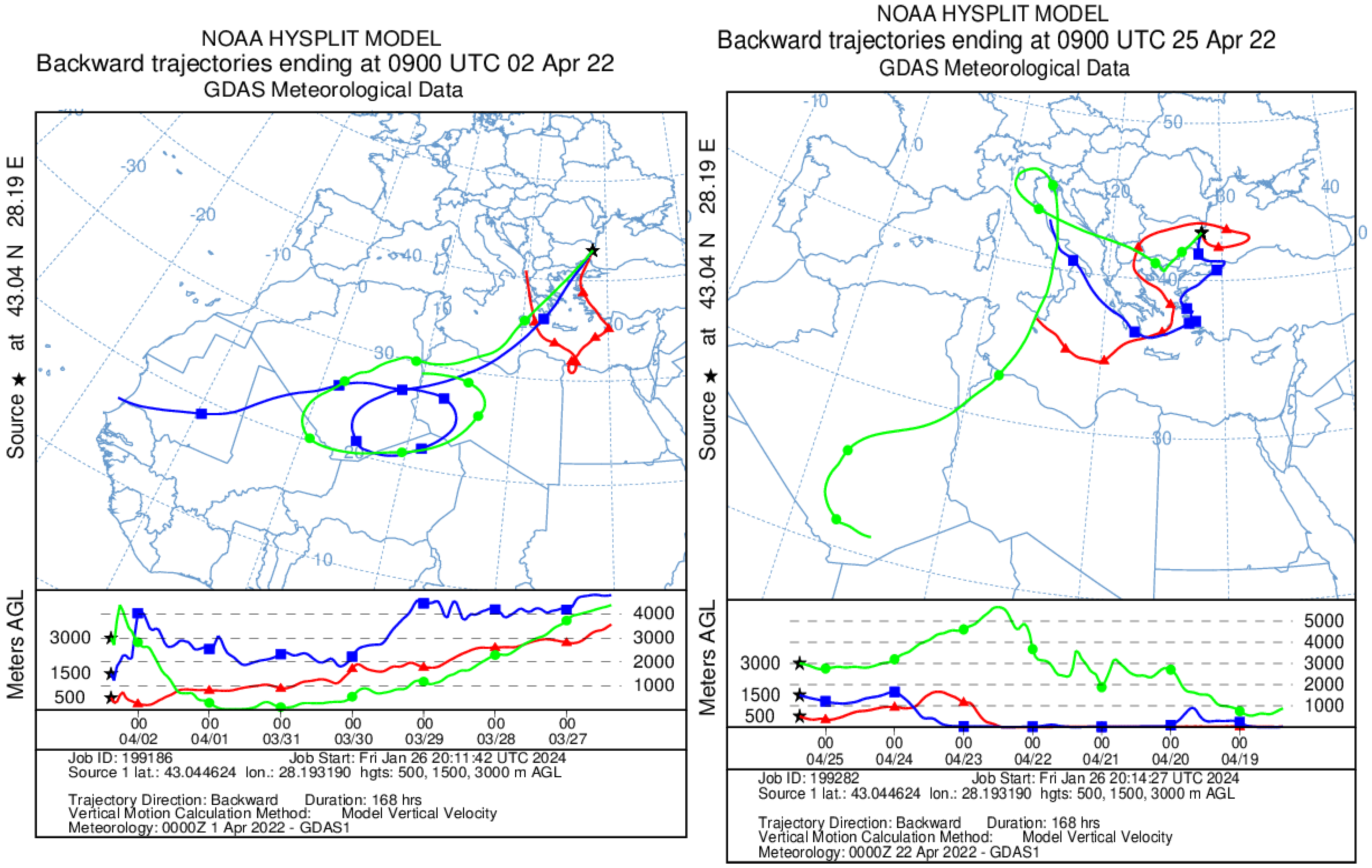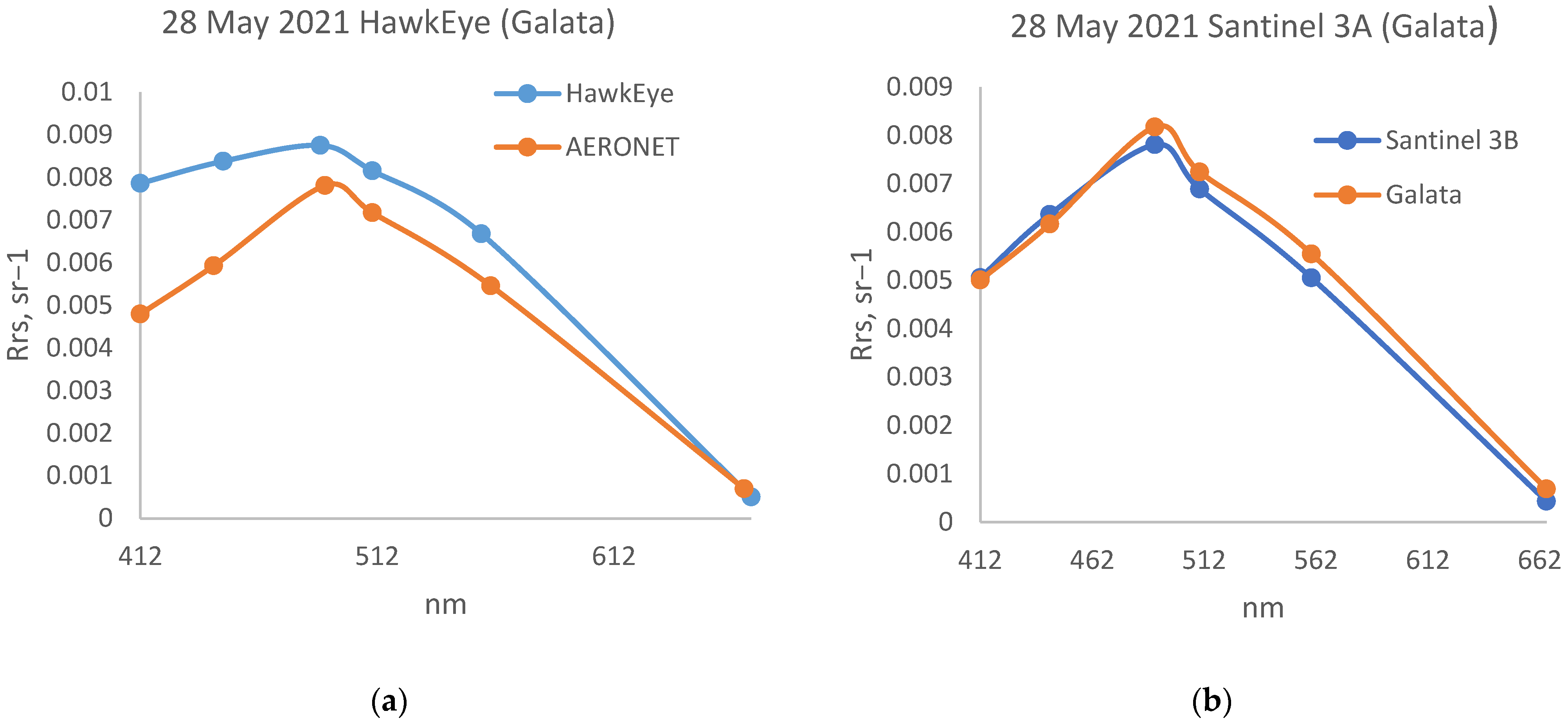Using HawkEye Level-2 Satellite Data for Remote Sensing Tasks in the Presence of Dust Aerosol
Abstract
1. Introduction
2. Materials and Methods
2.1. HawkEye Satellite, Technical Characteristics and Algorithm of Atmospheric Correction
2.2. In Situ Data, AERONET and AERONET OC Network, Portable Solar Spectrophotometer SPM
2.3. Additional Tools for Comparative Analysis and Confirmation of Dust Presence
3. Results and Discussion
4. Discussion
Author Contributions
Funding
Institutional Review Board Statement
Informed Consent Statement
Data Availability Statement
Acknowledgments
Conflicts of Interest
References
- Kabashnikov, V.; Milinevsky, G.; Chaikovsky, A.; Miatselskaya, N.; Danylevsky, V.; Aculinin, A.; Kalinskaya, D.; Korchemkina, E.; Bovchaliuk, A.; Pietruczuk, A.; et al. Localization of aerosol sources in East-European region by back-trajectory statistics. Int. J. Remote Sens. 2014, 35, 6993–7006. [Google Scholar] [CrossRef]
- Kalinskaya, D.V.; Papkova, A.S. Why Is It Important to Consider Dust Aerosol in the Sevastopol and Black Sea Region during Remote Sensing Tasks? A Case Study. Remote Sens. 2022, 14, 1890. [Google Scholar] [CrossRef]
- Ozdemir, E.; Tuygun, G.T.; Elbir, T. Application of aerosol classification methods based on AERONET version 3 product over eastern Mediterranean and Black Sea. Atmos. Pollut. Res. 2020, 11, 2226–2243. [Google Scholar] [CrossRef]
- Suslin, V.; Slabakova, V.; Kalinskaya, D.; Pryakhina, S.; Golovko, N. Optical Features of the Black Sea Aerosol and the Sea Water Upper Layer Based on In Situ and Satellite Measurements. Phys. Oceanogr. 2016, 1, 20–32. [Google Scholar]
- Papkova, A.; Papkov, S.; Shukalo, D. Prediction of the Atmospheric Dustiness over the Black Sea Region Using the WRF-Chem Model. Fluids 2021, 6, 201. [Google Scholar] [CrossRef]
- Korchemkina, E.N.; Kalinskaya, D.V. Algorithm of Additional Correction of Level 2 Remote Sensing Reflectance Data Using Modelling of the Optical Properties of the Black Sea Waters. Remote Sens. 2022, 14, 831. [Google Scholar] [CrossRef]
- Stefan, S.; Voinea, S.; Iorga, G. Study of the aerosol optical characteristics over the Romanian Black Sea Coast using AERONET data. Atmos. Pollut. Res. 2020, 11, 1165–1178. [Google Scholar] [CrossRef]
- Ștefănie, H.I.; Radovici, A.; Mereuță, A.; Arghiuș, V.; Cămărășan, H.; Costin, D.; Botezan, C.; Gînscă, C.; Ajtai, N. Variation of Aerosol Optical Properties over Cluj-Napoca, Romania, Based on 10 Years of AERONET Data and MODIS MAIAC AOD Product. Remote Sens. 2023, 15, 3072. [Google Scholar] [CrossRef]
- Osgouei, P.E.; Roberts, G.; Kaya, S.; Bilal, M.; Dash, J.; Sertel, E. Evaluation and comparison of MODIS and VIIRS aerosol optical depth (AOD) products over regions in the Eastern Mediterranean and the Black Sea. Atmos. Environ. 2022, 268, 118784. [Google Scholar] [CrossRef]
- Suetin, V.S.; Korolev, S.N.; Suslin, V.V.; Kucheryavy, A.A. Manifestation of features of the optical properties of atmospheric aerosol over the Black Sea in the interpretation of data from the SeaWiFS satellite instrument. Phys. Oceanogr. 2004, 1, 69–79. [Google Scholar]
- Kalinskaya, D.V.; Kabanov, D.M.; Latushkin, A.A.; Sakerin, S.M. Atmospheric aerosol optical thickness measurements in the Black sea region (2015–2016). Atmos. Ocean. Opt. 2017, 6, 489–496. [Google Scholar]
- Kaufman, Y.J.; Tanré, D.; Boucher, O. A satellite view of aerosols in the climate system. Nature 2002, 419, 215–223. [Google Scholar] [CrossRef] [PubMed]
- Suetin, V.S.; Korolev, S.N. Estimating Specific Features of the Optical Property Variability in the Black Sea Waters Using the Data of SeaWiFS and MODIS Satellite Instruments. Phys. Oceanogr. 2018, 25, 330–340. [Google Scholar] [CrossRef]
- Suetin, V.S.; Korolev, S.N. Application of Satellite Data for Retrieving the Light Absorption Characteristics in the Black Sea Waters. Phys. Oceanogr. 2021, 28, 205–214. [Google Scholar] [CrossRef]
- Korchemkina, E.N.; Shibanov, E.B.; Li, M.E. Improvement of the Atmospheric Correction Technique for Remote Investigations of Black Sea Coastal Waters. Issled. Zemli Kosmosa 2009, 6, 24–30. [Google Scholar]
- Parshikov, S.V.; Li, M.E. Remote sensing of optically active impurities using the short-wavelength part of the spectrum. In Automated Systems for Monitoring the State of the Marine Environment; MGI NAS of Ukraine: Sevastopol, Ukraine, 1992; pp. 65–78. [Google Scholar]
- Moulin, C.; Gordon, H.R.; Chomko, R.M.; Banzon, V.F.; Evans, R.H. Atmospheric correction of ocean color imagery through thick layers of Saharan dust. Geophys. Res. Lett. 2001, 28, 5–8. [Google Scholar] [CrossRef]
- Moulin, C.; Lambert, C.E.; Dayan, U.; Masson, V.; Ramonet, M.; Bousquet, P.; Legrand, M.; Balkanski, Y.J.; Guelle, W.; Marticorena, B.; et al. Satellite climatology of African dust transport in the Mediterranean atmosphere. J. Geophys. Res. Atmos. 1998, 103, 13137–13144. [Google Scholar] [CrossRef]
- Gordon, H.R. Evolution of Ocean Color Atmospheric Correction: 1970–2005. Remote Sens. 2021, 13, 5051. [Google Scholar] [CrossRef]
- Wei, J.; Yu, X.; Lee, Z.; Wang, M.; Jiang, L. Improving low-quality satellite remote sensing reflectance at blue bands over coastal and inland waters. Remote Sens. Environ. 2020, 250, 112029. [Google Scholar] [CrossRef]
- Schollaert, S.E.; Yoder, J.A.; O‘Reilly, J.E.; Westphal, D.L. Influence of dust and sulfate aerosols on ocean color spectra and chlorophyll a concentrations derived from SeaWiFS off the U.S. east coast. J. Geophys. Res. 2003, 108, 3191. [Google Scholar] [CrossRef]
- Mélin, F. Validation of ocean color remote sensing reflectance data: Analysis of results at European coastal sites. Remote Sens. Environ. 2022, 280, 113153. [Google Scholar] [CrossRef]
- Kopelevich, O.V.; Saling, I.V.; Vazyulya, S.V.; Glukhovets, D.I.; Sheberstov, S.V.; Burenkov, V.I.; Karalli, P.G.; Yushmanova, A.V. Biooptical Characteristics of the Seas Washing the Shores of the Western Half of Russia, According to Satellite Color Scanners 1998–2017; Kopelevich, O.V., Ed.; Shirshov Institute of Oceanology: Moscow, Russia, 2018; 140p, Available online: https://optics.ocean.ru/Atlas_2019/8_Monography_2018.pdf (accessed on 14 January 2021). (In Russian)
- Shybanov, E.B.; Papkova, A.S. Algorithm for Additional Correction of Remote Sensing Reflectance in the Presence of Absorbing Aerosol: Case Study. Phys. Oceanogr. 2022, 29, 688–706. [Google Scholar]
- Gordon, H.R.; Wang, W. Influence of oceanic whitecaps on atmospheric correction of SeaWiFS. Appl. Opt. 1994, 33, 7754–7763. [Google Scholar] [CrossRef] [PubMed]
- Ruddick, K.G.; Ovidio, F.; Rijkeboer, M. Atmospheric correction of SeaWiFS imagery for turbid coastal and inland waters. Appl. Opt. 2000, 39, 897–912. [Google Scholar] [CrossRef] [PubMed]
- Feng, L.; Hou, X.; Li, J.; Zheng, Y. Exploring the potential of Rayleigh-corrected reflectance in coastal and inland water applications: A simple aerosol correction method and its merits. ISPRS J. Photogramm. Remote Sens. 2018, 146, 52–64. [Google Scholar] [CrossRef]
- Hu, C.; Carder, K.L.; Muller-Karger, F.E. Atmospheric Correction of SeaWiFS Imagery over Turbid Coastal Waters: A Practical Method. Remote Sens. Environ. 2000, 74, 195–206. [Google Scholar] [CrossRef]
- Hu, C.; Lee, Z.; Franz, B. Chlorophyll aalgorithms for oligotrophic oceans: A novel approach based on three-band reflectance difference. J. Geophys. Res. Oceans 2012, 117, C01011. [Google Scholar] [CrossRef]
- Morel, A.; Claustre, H.; Gentili, B. The most oligotrophic subtropical zones of the global ocean: Similarities and differences in terms of chlorophyll and yellow substance. Biogeosciences 2010, 7, 3139–3151. [Google Scholar] [CrossRef]
- Shybanov, E.; Papkova, A.; Korchemkina, E.; Suslin, V. Blue Color Indices as a Reference for Remote Sensing of Black Sea Water. Remote Sens. 2023, 15, 3658. [Google Scholar] [CrossRef]
- Shybanov, E.B.; Papkova, A.S. Features of the atmospheric correction error in the presence of an absorbing aerosol over the sea. In Proceedings of the All-Russian Conference “Modern Problems” Optics of In-Situ Waters, St. Petersburg, Russia, 25–27 October 2023; pp. 233–237. [Google Scholar]
- Nousiainen, T.; Muinonen, K.; Räisänen, P. Scattering of light by large Saharan dust particles in a modified ray optics approximation. J. Geophys. Res. Atmos. 2003, 108, 4025. [Google Scholar] [CrossRef]
- Redmond, H.E.; Dial, K.D.; Thompson, J.E. Light Scattering and Absorption by Wind Blown Dust: Theory, Measurment, and Recent Data. Aeolian Res. 2009, 2, 5–26. [Google Scholar] [CrossRef]
- Min, M. Dust Opacities. EPJ Web Conf. 2015, 102, 00005. [Google Scholar] [CrossRef]
- Shybanov, E.; Papkova, A. Differences in the Ocean Color atmospheric correction algorithms for remote sensing reflectance retrievals for different atmospheric conditions. Sovrem. Probl. Distantsionnogo Zondirovaniya Zemli Iz Kosmosa 2022, 19, 9–17. [Google Scholar] [CrossRef]
- Papkova, A.; Kalinskaya, D.; Shybanov, E. Atmospheric correction according to the MODIS and VIIRS satellite data with considering the atmospheric pollution factor by a combination of different types of aerosol. In Proceedings of the 28th International Symposium on Atmospheric and Ocean Optics: Atmospheric Physics, Tomsk, Russia, 4–8 July 2022; Volume 12341, p. 123414G. [Google Scholar]
- Suslin, V.V.; Sholar, S.; Martynov, O.V. Baikal regional algorithm of diffuse attenuation coefficient based on HawkEye standard level-2 products. In Proceedings of the SPIE 28th International Symposium on Atmospheric and Ocean Optics: Atmospheric Physics, Tomsk, Russia, 4–8 July 2022; Volume 12341, p. 1234148. [Google Scholar] [CrossRef]
- Gregg, W.W.; Conkright, M.E. Decadal changes in global ocean chlorophyll. Geophys. Res. Lett. 2002, 29, 20-1–20-4. [Google Scholar] [CrossRef]
- Available online: https://oceancolor.gsfc.nasa.gov/data/hawkeye/on-orbit-changes/ (accessed on 17 January 2022).
- NASA/TM 2002–211617; The SeaWiFS Bio-Optical Archive and Storage System (SeaBASS): Current Architecture and Implementation. Goddard Space Flight Center: Greenbelt, MD, USA, 2002.
- Stumpf, R.P.; Arnone, R.A.; Gould, R.W., Jr.; Martinolich, P.M.; Ransibrahmanakul, V. A Partially coupled ocean-atmosphere model for retrieval of water-leaving radiance from SeaWiFS in coastal waters. In Algorithm Updates for the Fourth SeaWiFS Data Reprocessing; SeaWiFS Postlaunch Technical Report Series; NASA, Goddard Space Flight Center: Greenbelt, MD, USA, 2003; Volume 22. [Google Scholar]
- Carder, K.L.; Chen, F.R.; Lee, Z.P.; Hawes, S.K.; Kamykowski, D. Semianalytic Moderate-Resolution Imaging Spec-trometer algorithms for chlorophyll a and absorption with bio-optical domains based on nitrate-depletion temperatures. J. Geophys. Res. Ocean. 1999, 104, 5403–5422. [Google Scholar] [CrossRef]
- Gould, R.W., Jr.; Arnone, R.A.; Martinolich, P.M. Spectral dependence of the scattering coefficient in case 1 and case 2 waters. Appl. Opt. 1999, 38, 2377–2383. [Google Scholar] [CrossRef] [PubMed]
- Gordon, H.R.; Brown, O.B.; Evans, R.H.; Brown, J.W.; Smith, R.C.; Baker, K.S.; Clark, D.K. A semianalytic radiance model of ocean color. J. Geophys. Res. Atmos. 1988, 93, 10909–10924. [Google Scholar] [CrossRef]
- Bricaud, A.; Morel, A.; Babin, M.; Allali, K.; Claustre, H. Variations of light absorption by suspended particles with chlorophyll a concentration in oceanic (case 1) waters: Analysis and implications for bio-optical models. J. Geophys. Res. Oceans 1998, 103, 31033–31044. [Google Scholar] [CrossRef]
- Available online: https://oceancolor.gsfc.nasa.gov/data/hawkeye/data-collection-and-processing/ (accessed on 19 January 2022).
- Zibordi, G.; Holben, B.; Slutsker, I.; Giles, D.; D’alimonte, D.; Mélin, F.; Berthon, J.-F.; Vandemark, D.; Feng, H.; Schuster, G.; et al. AERONET-OC: A Network for the Validation of Ocean Color Primary Products. J. Atmos. Ocean. Technol. 2009, 26, 1634–1651. [Google Scholar] [CrossRef]
- Zibordi, G.; Mélin, F.; Berthon, J.-F.; Talone, M. In situ autonomous optical radiometry measurements for satellite ocean color validation in the Western Black Sea. Ocean Sci. 2015, 11, 275–286. [Google Scholar] [CrossRef]
- Thuillier, G.; Hersé, M.; Labs, D.; Foujols, T.; Peetermans, W.; Gillotay, D.; Simon, P.C.; Mandel, H. The Solar Spectral Irradiance from 200 to 2400 nm as Measured by the SOLSPEC Spectrometer from the Atlas and Eureca Missions. Sol. Phys. 2003, 214, 1–22. [Google Scholar] [CrossRef]
- Sakerin, S.M.; Kabanov, D.M.; Rostov, A.P.; Turchinovich, S.A.; Knyazev, V.V. Sun photometers for measuring spectral air transparency in stationary and mobile conditions. Atmos. Ocean. Opt. 2013, 26, 352–356. [Google Scholar] [CrossRef]
- Varenik, A.V.; Kalinskaya, D.V.; Myslina, M.A. Investigation of airborne particulate matter in the atmosphere of the Black sea coastal zone based on the measured and satellite data. Phys. Oceanogr. 2021, 28, 326–337. [Google Scholar] [CrossRef]
- Available online: https://ntm.ru/products/150/8342 (accessed on 30 January 2021).
- Stein, A.F.; Draxler, R.R.; Rolph, G.D.; Stunder, B.J.B.; Cohen, M.D.; Ngan, F. NOAA’s HYSPLIT Atmospheric Transport and Dispersion Modeling System. Bull. Am. Meteorol. Soc. 2015, 96, 2059–2077. [Google Scholar] [CrossRef]
- Omar, A.H.; Winker, D.M.; Vaughan, M.A.; Hu, Y.; Trepte, C.R.; Ferrare, R.A.; Lee, K.-P.; Hostetler, C.A.; Kittaka, C.; Rogers, R.R.; et al. The CALIPSO Automated Aerosol Classification and Lidar Ratio Selection Algorithm. J. Atmos. Ocean. Technol. 2009, 26, 1994–2014. [Google Scholar] [CrossRef]
- Omar, A.H.; Tackett, J.; Al-Dousari, A. CALIPSO Observations of Sand and Dust Storms and Comparisons of Source Types near Kuwait City. Atmosphere 2022, 13, 1946. [Google Scholar] [CrossRef]
- Sofiev, M.; Siljamo, P.; Ranta, H.; Linkosalo, T.; Jaeger, S.; Rasmussen, A.; Rantio-Lehtimaki, A.; Severova, E.; Kukkonen, J. A numerical model of birch pollen emission and dispersion in the atmosphere. Description of the emission module. Int. J. Biometeorol. 2013, 57, 45–58. [Google Scholar] [CrossRef]
- Available online: https://silam.fmi.fi/dust.html (accessed on 1 April 2023).
- Gobron, N.; Morgan, O.; Adams, J.; Brown, L.A.; Cappucci, F.; Dash, J.; Lanconelli, C.; Marioni, M.; Robustelli, M. Evaluation of Sentinel-3A and Sentinel-3B ocean land colour instrument green instantaneous fraction of absorbed photosynthetically active radiation. Remote Sens. Environ. 2021, 270, 112850. [Google Scholar] [CrossRef]
- Bailey, S.W.; Werdell, P.J. A multi-sensor approach for the on-orbit validation of ocean color satellite data products. Remote Sens. Environ. 2006, 102, 12–23. [Google Scholar] [CrossRef]
- Wang, M.; Son, S.; Harding, L.W., Jr. Retrieval of diffuse attenuation coefficient in the Chesapeake Bay and turbid ocean regions for satellite ocean color applications. J. Geophys. Res. Oceans 2009, 114, C11001. [Google Scholar] [CrossRef]
- Available online: https://aeronet.gsfc.nasa.gov/new_web/Documents/Inversion_products_V2.pdf (accessed on 21 April 2021).
- Available online: https://www-calipso.larc.nasa.gov/products/lidar/browse_images/production/ (accessed on 9 May 2023).
- Kim, M.-H.; Omar, A.H.; Tackett, J.L.; Vaughan, M.A.; Winker, D.M.; Trepte, C.R.; Hu, Y.; Liu, Z.; Poole, L.R.; Pitts, M.C.; et al. The CALIPSO version 4 automated aerosol classification and lidar ratio selection algorithm. Atmos. Meas. Tech. 2018, 11, 6107–6135. [Google Scholar] [CrossRef] [PubMed]
- Kalinskaya, D.V.; Suslin, V.V. A simple method for identifying surface aerosol sources based on back-path analysis results. Fundam. Appl. Hydrophys. 2015, 8, 59–67. [Google Scholar]
- Suetin, V.S.; Kucheryavy, A.A.; Suslin, V.V.; Korolev, S.N. Concentration of phytoplankton pigments in the northwestern part of the Black Sea based on data of measurements by satellite color scanner CZCS. Mar. Hydrophys. J. 2000, 2, 74–82. [Google Scholar]
- Khalturin, V.I.; Suetin, V.S.; Shutikov, S.P. On a Low-Parameter Model of the Optical Properties of Sea Water; Dep. VINITI (Moscow): Moscow, Russia, 1984; No. 3548-84; 13p. [Google Scholar]
- D’alimonte, D.; Shybanov, E.B.; Zibordi, G.; Kajiyama, T. Regression of in-water radiometric profile data. Opt. Express 2013, 21, 27707–27733. [Google Scholar] [CrossRef] [PubMed]
- Seegers, B.N.; Stumpf, R.P.; Schaeffer, B.A.; Loftin, K.A.; Werdell, P.J. Performance metrics for the assessment of satellite data products: An ocean color case study. Opt. Express 2018, 26, 7404–7422. [Google Scholar] [CrossRef]
- Zibordi, G.; Kwiatkowska, E.; Mélin, F.; Talone, M.; Cazzaniga, I.; Dessailly, D.; Gossn, J.I. Assessment of OLCI-A and OLCI-B radiometric data products across European seas. Remote Sens. Environ. 2022, 272, 112911. [Google Scholar] [CrossRef]






| Data | Station | AOD (412) | AOD (443) | AOD (510) | AOD (865) | α | PM |
|---|---|---|---|---|---|---|---|
| 28 May 2021 | Galata | 0.282 | 0.255 | 0.210 | 0.103 | 1.386 | - |
| Section_7 | 0.245 | 0.226 | 0.19 | 0.111 | 1.068 | - | |
| AOT(441) | AOT(501) | AOT(872) | |||||
| MHI | 0.197 | 0.177 | 0.165 | 0.632 | |||
| 26 July 2021 | Galata | 0.252 | 0.225 | 0.179 | 0.070 | 1.780 | fine |
| Section_7 | 0.267 | 0.236 | 0.19 | 0.077 | 1.724 | fine | |
| 27 July 2021 | Galata | 0.266 | 0.247 | 0.215 | 0.134 | 0.979 | coarse |
| Section_7 | 0.267 | 0.243 | 0.208 | 0.118 | 1.111 | coarse | |
| 28 July 2021 | Galata | 0.304 | 0.284 | 0.252 | 0.170 | 0.783 | coarse |
| Section_7 | 0.343 | 0.317 | 0.279 | 0.177 | 0.887 | coarse | |
| 17 August 2021 | Galata | 0.111 | 0.099 | 0.081 | 0.032 | 1.742 | fine |
| Section_7 | 0.12 | 0.106 | 0.089 | 0.039 | 1.576 | fine/coarse | |
| 26 September 2021 | Galata | 0.132 | 0.119 | 0.095 | 0.042 | 1.560 | coarse |
| Section_7 | 0.134 | 0.119 | 0.098 | 0.044 | 1.545 | fine/coarse | |
| 5 November 2021 | Galata | 0.084 | 0.08 | 0.071 | 0.049 | 0.751 | coarse |
| Section_7 | 0.152 | 0.145 | 0.131 | 0.087 | 0.818 | coarse | |
| MHI | 0.075 | 0.065 | 0.059 | 1.006 | |||
| 17 February 2022 | Galata | 0.28 | 0.268 | 0.243 | 0.181 | 0.600 | coarse |
| Section_7 | 0.283 | 0.270 | 0.246 | 0.175 | 0.667 | coarse | |
| MHI | 0.259 | 0.246 | 0.237 | 0.366 | |||
| 2 April 2022 | Galata | 0.151 | 0.146 | 0.134 | 0.108 | 0.488 | coarse |
| Section_7 | 0.073 | 0.067 | 0.06 | 0.036 | 0.989 | - | |
| MHI | 0.204 | 0.193 | 0.187 | 0.361 | |||
| 25 April 2022 | Galata | 0.221 | 0.209 | 0.185 | 0.137 | 0.667 | coarse |
| Section_7 | 0.193 | 0.178 | 0.143 | 0.104 | 0.966 | coarse | |
| MHI | 0.101 | 0.088 | 0.080 | 0.924 | |||
| 17 May 2022 | Galata | 0.234 | 0.209 | 0.166 | 0.074 | 1.560 | fine |
| Section_7 | 0.364 | 0.326 | 0.263 | 0.114 | 1.594 | fine | |
| MHI | 0.296 | 0.248 | 0.215 | 1.512 |
| Date and Station | AOT(867)_H | AOT(865)_A | α_H | α_A | Quality % | Description |
|---|---|---|---|---|---|---|
| 28 May 2021 Galata | 0.1255 | 0.103 | 0.6842 | 1.386 | 53 | Low α, low aerosol load, marine polluted aerosol, cloud cover |
| 27 July 2021 Galata | 0.1074 | 0.134 | 0.6842 | 0.979 | 62 | AOD and α are slightly overestimated, Polluted marine + continental + dust aerosol, haze |
| 28 July 2021 Galata | 0.1634 | 0.170 | 0.6842 | 0.783 | 16 | Slightly overestimated α, dust aerosol |
| 17 August 2021 Galata | 0.0485 | 0.032 | 0.6842 | 1.742 | 60 | α is underestimated by 2.5 times, polluted dust and clean marine aerosol |
| 26 September 2021 Galata | 0.0822 | 0.042 | 0.6842 | 1.560 | 65 | AOD is underestimated by 2 times, α is overestimated by 2 times, polluted marine aerosol |
| 5 November 2021 Galata | 0.0614 | 0.049 | 0.6842 | 0.751 | 1 | AOD is slightly underestimated, α is slightly overestimated, cloud cover, dust aerosol |
| 17 February 2022 Galata | 0.2469 | 0.181 | 0.6842 | 0.600 | 2 | The AOD is greatly overestimated, cloud cover, the presence of dust aerosol and polluted dust |
| 2 April 2022 Galata | 0.1034 | 0.108 | 0.6842 | 0.488 | 16 | Slightly overestimated α, dust aerosol |
| 25 April 2022 Galata | 0.1504 | 0.137 | 0.6842 | 0.667 | 85 | AOD is slightly overestimated, dust aerosol, cloud cover |
| 26 July 2021 Section_7 | 0.1075 | 0.077 | 0.6842 | 1.545 | 63 | α is underestimated by 2.5 times, the presence of fine polluted marine aerosol particles |
| 27 July 2021 Section_7 | 0.1062 | 0.118 | 0.6842 | 1.111 | 25 | The α is underestimated, the presence of a marine and dust aerosol |
| 17 February 2022 Section_7 | 0.2473 | 0.175 | 0.6842 | 0.667 | 27 | Overestimated AOD, dust aerosol |
| 2 April 2022 Section_7 | 0.0699 | 0.036 | 0.6842 | 0.989 | 53 | Overestimated AOD, understated α, dusty, cloudy |
| 17 May 2022 Section_7 | 0.219 | 0.114 | 0.6842 | 1.594 | 2 | AOD is overestimated by 2 times, α is underestimated by 2.5 times, fine aerosol |
| Data/Rrs(λ) | 412 nm | 447 nm | 490 nm | 510 nm | 556 nm | 670 nm | Slope | |
|---|---|---|---|---|---|---|---|---|
| 28 May 2021 Galata | −0.00306 | −0.00245 | −0.00094 | −0.00098 | −0.00122 | 0.000193 | −5.260 | 0.916 |
| 27 July 2021 Galata | −0.00014 | −0.00145 | −0.00091 | −0.00073 | −0.00082 | 0.000207 | −1.481 | 0.125 |
| 28 July 2021 Galata | 0.003183 | 0.000248 | 0.001139 | 0.000845 | 0.001018 | 0.000325 | −7.017 | 0.609 |
| 17 August 2021 Galata | 0.001112 | −0.0009 | 7.86 × 10−6 | −0.00046 | −0.00049 | 0.000138 | −9.457 | 0.134 |
| 26 September 2021 Galata | 0.000497 | −0.00152 | −4.3 × 10−5 | −2.3 × 10−5 | 0.000481 | 0.000394 | −4.395 | 0.023 |
| 5 November 2021 Galata | 0.004687 | 0.002371 | 0.003015 | 0.002984 | 0.002297 | 0.000519 | −2.774 | 0.783 |
| 17 February 2022 Galata | 0.003343 | 0.002139 | 0.000762 | 0.000839 | −0.00111 | 2.74 × 10−5 | −8.837 | 0.825 |
| 2 April 2022 Galata | 0.001837 | 0.00039 | 0.000887 | 0.00102 | 0.001232 | 0.000643 | −1.582 | 0.244 |
| 25 April 2022 Galata | 0.002529 | 0.000254 | 0.000446 | 0.000354 | 0.000644 | 0.000562 | −9.457 | 0.702 |
| 26 July 2021 Section_7 | −0.00284 | −0.00185 | −8.8 × 10−5 | 0.000172 | −0.00035 | 7.44 × 10−5 | −9.457 | 0.905 |
| 27 July 2021 Section_7 | 0.001592 | −0.00062 | 0.000546 | 0.000737 | 0.001001 | 0.000819 | 0.325 | 0.003 |
| 17 February 2022 Section_7 | 0.004708 | 0.000261 | −0.00077 | −0.00149 | −0.00156 | 6.95 × 10−5 | −9.457 | 0.552 |
| 2 April 2022 Section_7 | 0.00048 | −0.00127 | 0.000408 | −0.00025 | 0.001001 | 0.000613 | 3.457 | 0.126 |
| 17 May 2022 Section_7 | −0.00519 | −0.00559 | −0.00348 | −0.00254 | −0.0019 | 0.000534 | −3.931 | 0.836 |
Disclaimer/Publisher’s Note: The statements, opinions and data contained in all publications are solely those of the individual author(s) and contributor(s) and not of MDPI and/or the editor(s). MDPI and/or the editor(s) disclaim responsibility for any injury to people or property resulting from any ideas, methods, instructions or products referred to in the content. |
© 2024 by the authors. Licensee MDPI, Basel, Switzerland. This article is an open access article distributed under the terms and conditions of the Creative Commons Attribution (CC BY) license (https://creativecommons.org/licenses/by/4.0/).
Share and Cite
Papkova, A.; Kalinskaya, D.; Shybanov, E. Using HawkEye Level-2 Satellite Data for Remote Sensing Tasks in the Presence of Dust Aerosol. Atmosphere 2024, 15, 617. https://doi.org/10.3390/atmos15050617
Papkova A, Kalinskaya D, Shybanov E. Using HawkEye Level-2 Satellite Data for Remote Sensing Tasks in the Presence of Dust Aerosol. Atmosphere. 2024; 15(5):617. https://doi.org/10.3390/atmos15050617
Chicago/Turabian StylePapkova, Anna, Darya Kalinskaya, and Evgeny Shybanov. 2024. "Using HawkEye Level-2 Satellite Data for Remote Sensing Tasks in the Presence of Dust Aerosol" Atmosphere 15, no. 5: 617. https://doi.org/10.3390/atmos15050617
APA StylePapkova, A., Kalinskaya, D., & Shybanov, E. (2024). Using HawkEye Level-2 Satellite Data for Remote Sensing Tasks in the Presence of Dust Aerosol. Atmosphere, 15(5), 617. https://doi.org/10.3390/atmos15050617





